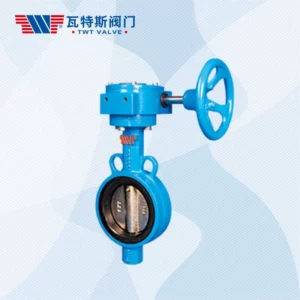A wafer butterfly valve is a type of butterfly valve that is compact, lightweight, and designed for use in applications where space is limited. It consists of several main components that work together to control the flow of fluid through a piping system.
The main components of a wafer butterfly valve include:
- Body: The body of the wafer butterfly valve provides the outer casing that houses the internal components of the valve and serves as the connection point between the valve and the piping system. It typically has a wafer-style design, which means it is sandwiched between two pipe flanges using bolts or studs.
- Disc: The disc, also known as the butterfly or rotor, is the central component of the valve that controls the flow of fluid. It is disc-shaped and rotates within the valve body to open or close the flow passage. The disc is mounted on a shaft that extends through the center of the valve body.
- Shaft: The shaft is a cylindrical rod that connects the disc to the actuator or handle of the valve. It transmits the torque from the actuator to the disc, allowing the disc to rotate and modulate the flow of fluid through the valve.
- Seat: The seat is a sealing element located around the perimeter of the flow passage within the valve body. It provides a tight seal against the disc when the valve is closed, preventing leakage of fluid through the valve. The seat is typically made of resilient material, such as rubber or elastomer, to ensure a reliable seal.
- Actuator: The actuator is the mechanism responsible for operating the valve, either manually or automatically. It applies the force or torque required to rotate the disc and control the flow of fluid through the valve. Actuators can be operated using various methods, including hand wheels, levers, gears, pneumatic cylinders, or electric motors.
- Stem: In some wafer butterfly valve designs, a stem is used to connect the shaft to the actuator. The stem provides a means of transferring motion from the actuator to the shaft, allowing the disc to be rotated for opening or closing the valve.
- Body Flanges: Wafer butterfly valves are typically installed between two pipe flanges using bolts or studs. The body flanges of the valve are designed to match the flange dimensions of the piping system, allowing for secure attachment and sealing between the valve and the pipeline.
These are the main components of a wafer butterfly valve, each playing a crucial role in controlling the flow of fluid through the valve and ensuring reliable operation in various industrial applications.

What are the main components of a wafer butterfly valve?
